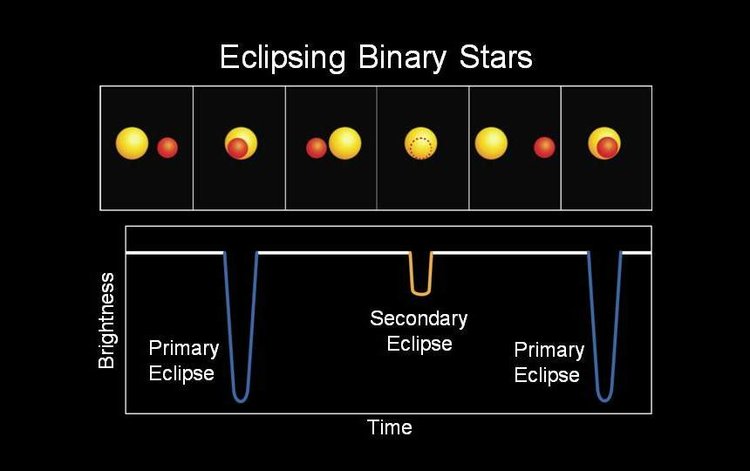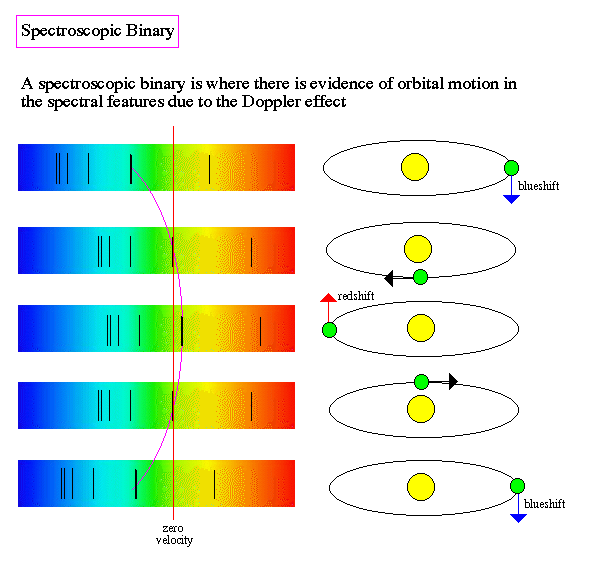Binary Stars (Kaushikee Biswas)

This blog post was the first runner up of Estrella in AstraX 2021. “Only In The Darkness Can You See The Stars” - Martin Luther King Jr.
The bright spots of light that adorn the night sky are the stars which are thousands of miles away from us. Interestingly most of these bright spots are not a single star rather they are the binary or multiple star systems but appear as a single spot since they are so far from us.
These stars are huge massive bodies and are able to exert gravitational effects on each other, thus giving rise to stellar evolutions, Supernova and many more wonderful events.
The two stars present in a binary system are referred with their names suffixed with A and B. The brighter one is referred with A and is the primary star. The dimmer and the less massive star is referred to with B and called the secondary star.
Classification of binary star system:
The term double star is frequently used with binary stars…. double stars refer to optical doubles. These are named so because when seen from the Earth they appear as a single bright spot and not distinctly visible because they lie in the same line of sight. They are not physical pairs, just projection effects. Hence, they are not true binary star systems.
For example, in the Big dipper, stars Alcor and Mizar appear at the same spot.
Visual binaries
These are the binary star systems that can be viewed with telescopes. 5 -10% of visual stars are visual binaries.
By definition a binary star system comprises of 2 stars orbiting around their common barycentre.
Example of visual binaries: - Krueger 60
The major categories of Visual binaries are:
- Astrometric binary
In this case only one of the stars is visible and the other binary companion remains invisible to us because it may be too faint or small to be viewed. It appears that the visible star wobbles about the centre of mass.
Example of this category is Sirius A and Sirius B, Sirius A being brighter can be only seen.
- Spectroscopic binary
Here we see only a single source of light. The study about these binaries is done by observation of the wavelength of light emitted by stars using Doppler’s shift which is periodic and opposite. When a star comes closer towards the earth, we observe blue shift and when it moves away, we observe redshift, the time gap between a red shift to Blue shift and again back to redshift consist of the orbital period.
Many a times the plane of the orbit may be tilted with respect to to our line of sight, in that case we obtain the radial velocities and plot the velocity curves for spectroscopic binary. True velocities are known if inclination angle with the line of sight is known.
Examples include Mirza A and Mirza B.

- Eclipsing Binary
When the plane of the orbit of the Binary is same as the plane of our line of sight, we will observe eclipsing binaries one star will pass in front of the other and we will observe variation in brightness of light received by us.
-
By plotting a curve between brightness of light received and time we can calculate the orbital time period
-
Also measuring the duration of eclipses, we can find out the size of the star
John Goodricke, the famous astronomer observed that Algol gets dimmer periodically by one third of its normal brightness.

Binaries are also categorised as
-
Wide Binaries: - They evolve separately and do not influence one another much.
-
Close binaries: - They evolve nearly, mass exchange from one to another may take place. Sometimes if gravitational pull may be large enough the smaller star may be pulled completely. There’s interesting phenomenon involving these close binaries,.. Roche lobe overflow, mass transfer etc. Let’s look deeper!
The Roche Lobes are regions around the stars of the binary system within which the orbiting materials are gravitationally bound to the star. It is in the shape of a teardrop, bounded by gravitational equipotential surface. Materials out of the Roche Lobes may escape the system entirely or fall onto its binary companion.
Roche Lobes overflow

If one or both the stars swell beyond its Roche Lobes it is termed as Roche Lobes overflow.
Mass transfer occurs and material beyond the Roche Lobe flows onto the binary companion through Lagrangian point (where gravity of two stars cancels). This results in expansion of the smaller star by formation of accretion disc. Let’s look into the mass exchange process and outcomes.
Initially both the stars are well inside their Roche Lobes. But then the higher mass star begins to expand and forms a red giant star. It overflows the Roche Lobes; the material gets pulled to the companion star.
This way the once more massive star becomes the less massive one. The more massive star initially begins to form a Red Giant then white dwarf. The white dwarf then attracts material from its companion to become a red giant once again. If the white dwarf gains mass rapidly and crosses the Chandrasekhar limit (1.4 Mass of sun) it becomes a type 1A Supernova.
A thought that can shoot up in our mind, Can in any way life evolve in these star systems……? Let’s find out how planets and the stars are oriented among each other.
There can be two types of planetary orbit in case of binary star system P Type Orbit: Planet remains outside the orbit of two stars S type Orbit: Let the two stars in the binary star system be A and B. If the planet stays around star A but Star B Orbit remains outside the planet’s orbit it is S type Orbit.
In the Habitable zones, also known as Goldilocks zones the planets can exist and support life. The temperature is not too high, nor too low, water exists as liquid on the surface of the planets.
In the wider Binary System, the situation is complex since both the stars have their gravitational influences and it is difficult to form planets in habitable zones. An important rule for planets to exist when the binary stars’ wider orbit is in the same plane as the planets, if the planetary orbit is larger than one third of the binary stars’ orbit then the planet is not stable and will not exist.
These Binary Stars systems are one the most vibrant constituents of the Universe. Humans may always be engaged to discover new planets in habitable zones, or may someday spot out a white Dwarf which had once been a Red giant. Visible to us as glitters sprinkled on the dark carpet, the “Estrella” s are immensely dynamic and certainly an interesting subject of study.
Bibliography:
- Image sources: https://commons.wikimedia.org/wiki/File:Roche-comenv.svg, https://www.scienceatyourdoorstep.com, https://www.howknowledgeworks.com, Wikimedia, NASA
- https://www.space.com
- https://www.bbc.co.uk
- https://www.atnf.csiro.au
- The Double Star Library, at the U.S. Naval Observatory
- “Mass Transfer in Binary Star Systems” by Jeff Bryant with Waylena McCully, Wolfram Demonstrations Project
 Never miss a story from us, subscribe to our newsletter
Never miss a story from us, subscribe to our newsletter